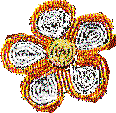
MIINENSAGAAWUNZH -- THE HAWTHORNE TREE
Page Buttons  |
|---|
| Manidoominens, sacred seeds/fruit of the hawthorn tree, is the Anishinaabemowin word that women gave to the little seed beads which are the glory of the beadworker's art. | 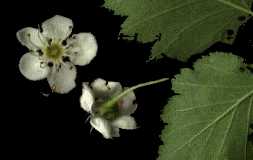 |
 You can see how this fragrant 5-petaled flower inspired the so-called daisy (daisies actually have many more and narrower petals) which is so easy to learn it is usually the first pattern very young girls learn bead embroidery by doing. The hawthorn blooms in May. (One of the names for the European species is Mayflower -- which gave its name to the ship that brought the Pilgrims to New England in the early 17th century.) The showy white or pink blossoms help to give the Anishnaabemowin name Waabigwanii-giizis -- the Moon of Flowers -- to the month of May. Wildflowers, leaves, fruits were the themes of Woodland (especially Ojibwe) floral beadwork, done with double-needle applique bead embroidery. If you want to see wildflowers that inspired beadworkers of the late 19th century and still inspire us now, there are some excellent websites of Wildflower photography -- this virtual wild garden begins with several species of the Ladyslipper (a wild orchid), including the one sometimes called Moccassin flower. A University of Wisconsin botanist specializes in them. Here you can find out all the scoop on this flower.
Looking carefully at such flower pix, you will recognize some of their shapes in Woodland bead embroidery, though those are always artistic re-patternings and simplifications of the natural flower. Woodland bead artists freely combine many different species (and seasonal appearances) on one scroll-like vine with spiraling tendrils. Women used to save, press, then make cut-out birch-bark beading patterns from unusual flowers or leaves. |
|---|
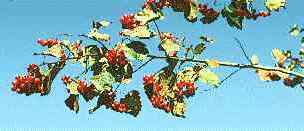 |
Here is a branch of fall-ripened fruit of the Miinensagaawunzh tree. |
|---|---|
These aren't exactly berries (botannically), these fruits that gave their name to Manidoominens, sacred seed beads. The Hawthorn is a member of the Rosaceae family (Crataegus coccinea -- American species; oxycantha, European), and is related not only to roses, but also to peach, almond and apple trees, and to the sacred strawberry, ode'imin, heartberry, that gives its name to the month of June, Ode'imini-giizis, the Moon when Strawberries ripen. Miinensagaawunj was used in ways no longer remembered for "women's remedies". It may have been for fertility, because the word particle sagaa once meant "sprouting, germinating, making seed sprout or germinate." The word-ending -wunj is applied to a few special kinds of plants and means roughly "It has those parts (woody stem, bark, woody roots etc.) for a certain reason." The certain reason indicates that women's medicine secrets attach to this type of plant. Modern (German) herbalists now consider a strong tea of hawthorn to be a valuable heart disease preventative. It opens coronary arteries, helps eliminate some types of rhythm disturbances, and limits or helps dissolve cholestrol deposits. The species used is of course European, but more than 3 dozen hawthorn-based medicines are available in Germany, and scientific studies done there support its medical usefulness. | |
| The hawthorn tree's name -- miinesagaawunj -- was also the name of very sharp awls made from its thorns. This one (1910 photo) was stored with a coil of split sinew in a very old sewing kit. Trade goods needles were instantly adopted; metal awls are still used on heavy buckskin. |  |
|
So the more we learn about this plant and its history -- and parts of that history preserved in Anishaabemowin -- the more we can see how much sense it still makes to call the beautiful little beads that can be used to create such beauty "Manidoominens", a sacred gift of special, colorful, long-lasting little seeds (with convenient holes in them) transmogrified from plant seeds. It can put you into a very good frame of mind, to think about these things when you are beading. Other tribes have other names for beads, and perhaps other stories and lore about them. So much has been preserved for Ojibwe people because Frances Densmore, a musicologist who became an ethnographer, spent many years with Ojibwe people (especially women) in Minnesota, Wisconsin and Canada -- from 1905 until 1927. Densmore was highly interested in women's crafts and all aspects of ordinary daily life, as well as the Midèwewin and other songs she recorded in musical notation and the primitive technology of the time.
|
|




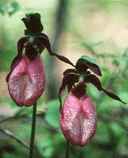 The Ojibwe word Agobisowin -- "to be sewn on made of fine small things" -- is an old White Earth Anishinaabemowin name for this flower, obviously in reference to its use as a beadwork pattern. It was also used as a toothache remedy. Agogwaadan is a present-day word meaning "to sew something (like beads) onto some material."
The Ojibwe word Agobisowin -- "to be sewn on made of fine small things" -- is an old White Earth Anishinaabemowin name for this flower, obviously in reference to its use as a beadwork pattern. It was also used as a toothache remedy. Agogwaadan is a present-day word meaning "to sew something (like beads) onto some material." 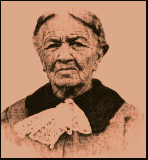 Densmore was fortunate to have as interpreter, friend, and fellow worker, Mary Warren English, respected Ojibwe teacher and elder, who died in 1927. Her brother, William Warren (1825-1853) is much better known for his History of the Ojibway People written from interviews with his elder relatives, in 1851. Mary Warren English is known only from Densmore's biographical note about her -- and fragmentary recollections of her Minnesota White Earth and Red Lake reservation descendants. Because two talented women from the two cultures cared to preserve it, much knowledge that gives meaning to Native traditions and the small things of everyday life still survives, despite all the changes that have occurred in those ways of life. In particular, these women preserved information about Ojibwe bead embroidery. For beadwork, Densmore not only made many photos of tools, patterns, and examples but also preservwd many of the words for everything from tools to plants, that were used in the crafts and in day-to-day tasks -- something almost no ethnographers of the early period did -- almost entirely men -- bothered to do.
Densmore was fortunate to have as interpreter, friend, and fellow worker, Mary Warren English, respected Ojibwe teacher and elder, who died in 1927. Her brother, William Warren (1825-1853) is much better known for his History of the Ojibway People written from interviews with his elder relatives, in 1851. Mary Warren English is known only from Densmore's biographical note about her -- and fragmentary recollections of her Minnesota White Earth and Red Lake reservation descendants. Because two talented women from the two cultures cared to preserve it, much knowledge that gives meaning to Native traditions and the small things of everyday life still survives, despite all the changes that have occurred in those ways of life. In particular, these women preserved information about Ojibwe bead embroidery. For beadwork, Densmore not only made many photos of tools, patterns, and examples but also preservwd many of the words for everything from tools to plants, that were used in the crafts and in day-to-day tasks -- something almost no ethnographers of the early period did -- almost entirely men -- bothered to do. 